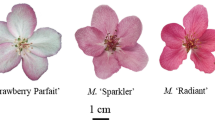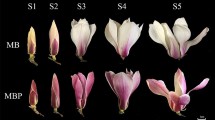Abstract
The fading of flower color in bluish purple and reddish purple cultivars of Iris ensata and the in vitro stability of malvidin 3RGac5Gand petunidin 3RGac5G due to copigmentation with isovetixin under different pH conditions were examined. The bluish purple cultivars exhibited higher flower color stability than the reddish purple cultivars 2 days after anthesis. In the absence of isovitexin, malvidin 3RGac5G and petunidin 3RGac5G were not able to maintain color stability except at low pH. However, the color stability of malvidin 3RGac5G and petunidin 3RGac5G was increased by copigmentation with isovitexin under all pH conditions tested. Most remarkable was the stabilization of both anthocyanins due to the copigmentation at pH 4.2–6.2. Therefore, it can be concluded that the stability of flower color in the bluish purple cultivars of malvidin 3RGac5Gand petunidin 3RGac5G type of I. ensata is caused at least in part by the copigmentation between these anthocyanins and isovitexin.
Similar content being viewed by others
References
Asen, S., R.N. Stewart, K.H. Norris & D.R. Massie, 1970. A stable blue non-metalic copigment complex of delphanin and C-glycosylflavones in Prof. Blaauw Iris. Phytochem 9: 619-627.
Brouillard, R., 1988. Flavonoids and flower color. In: J.B. Harborne (Ed.), The Flavonoids, pp. 525-538. Chapman & Hall, London.
Goto, T. & T. Kondo, 1991. Structure and molecular staching of anthocyanins-Flower color variation. Angew Chem Int Ed Engl 30: 17-33.
Iwashina, T., K. Kamenosono & T. Yabuya, 1996. Isolation and identification of flavonoid and related compounds as co-pigments from the flowers of Iris ensata. J Jpn Bot 71: 281-287.
Saito, N., 1989. Seishokuka-no-Shikiso-to-Kashoku-no-Anteika. Bio Horti 2: 49-59 (in Japanese).
Takeda, K., 1994. Advances in research on flower color variation in Japan, especially on blue flower color. Ikushugaku-saikinno-Shinpo 36: 47-50 (in Japanese).
Yabuya, T., 1991. High-performance liquid chromatographic analysis of anthocyanins in Japanese garden iris and its wild forms. Euphytica 52: 215-219.
Yabuya, T., M. Nakamura & T. Iwashina, 1994. Flower color variation due to copigments in Japanese garden iris, Iris ensata Thunb. Proc of IPBA, Rogla, pp. 239-250.
Yabuya, T., M. Nakamura, T. Iwashina, M. Yamaguchi & T. Takehara, 1997. Anthocyanin-flavone copigmentation in bluish purple flowers of Japanese garden iris (Iris ensata Thunb.). Euphytica 98: 163-167.
Yabuya, T., T. Imayama, T. Shimomura, R. Urushihara & M. Yamaguchi, 1999. HPLC analysis of anthocyanins in Japanese garden iris and its wild species (3). Breeding Research 1 (Suppl 1): 145 (in Japanese).
Author information
Authors and Affiliations
Rights and permissions
About this article
Cite this article
Yabuya, T., Saito, M., Iwashina, T. et al. Stability of flower colors due to anthocyanin-flavone copigmentation in Japanese garden iris, Iris ensata Thunb.. Euphytica 115, 1–5 (2000). https://doi.org/10.1023/A:1003916417168
Issue Date:
DOI: https://doi.org/10.1023/A:1003916417168




